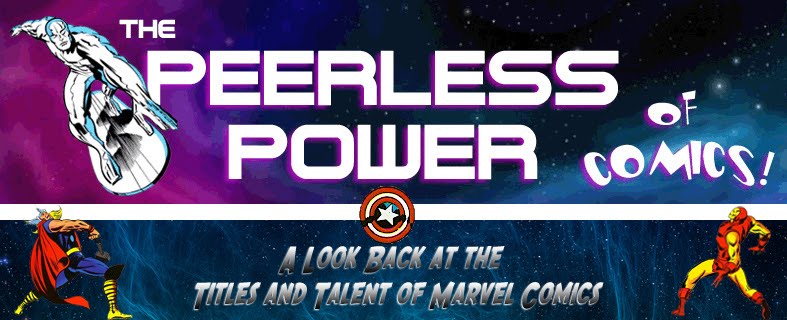Most of you are probably familiar with the woman named
Barbara Norris from the pages of
The Defenders, either when she was rescued from the dimension of the Undying Ones or through her association with the woman warrior called the Valkyrie. Yet we first met her when she and her husband, Jack, were cultists attempting to bridge the path to Earth for the Undying Ones by using the Hulk to remove
the Night-Crawler, the guardian of the border between the two dimensions.
As we can see, Barbara is having second thoughts about what they're doing, particularly now that they've helped to put the life of an innocent man in danger. And Barbara's doubts haven't gone unnoticed by Van Nyborg, the cult's leader, who has her seized and hurled into the void to share Banner's fate. Yet when the Hulk appears and fights to protect Barbara, she stands valiantly with him and even acts to save him--though the conflict escalates to the point where the domain of the Night-Crawler is destroyed, forcing them all to transport to the universe of the Undying Ones.
And that universe has been
visited before, by the Sub-Mariner and Dr. Strange--with Strange sacrificing himself in order to allow Namor to escape. And now, Barbara, finding herself in the same position, doesn't hesitate to act to save both Strange and the Hulk.
Cut to 2½ years later, when the Defenders assemble (heh) to help the Silver Surfer escape his imprisonment on Earth by moving dimensionally past the barrier of Galactus. Only the dimension which they find themselves in rings familiar to all three Defenders, especially when they come across a mystic prison that once held Strange and
still appears to hold the girl who helped him to gain his freedom.
Yet the Defenders have fallen for an elaborate ruse by the Nameless One, two conjoined monsters who now shockingly reveal themselves as having mated with their former captive.
The battle between the Defenders and the Nameless One is fierce--but the ethereal prison that trapped both Strange and Barbara would now serve to trap their former jailer, thanks to snares devised by Strange and the Surfer. And yet Strange still sees Barbara as a captive of their foe, and moves to help her--with unfortunate consequences.
We could argue that Barbara was already doomed by the time the Defenders arrived, and that Strange's rash albeit well-intentioned intervention made little difference in regard to her fate--but hold that thought for a bit.
When the Defenders return to Earth (with Barbara), they
fall into a plot by the Enchantress to reclaim her partner, the Executioner, from a rival sorceress, Casiolena--and when the Enchantress decides to conjure some backup, the Valkyrie makes her debut appearance in the book.
Following that episode, and abandoned by the Enchantress, the Valkyrie decides to cast her lot with the Defenders, her persona continuing to completely suppress that of Barbara. Yet we know that, by the time of the book's cancellation thirteen years later to the month, the Valkyrie had fully reclaimed and embraced her Asgardian heritage.
Which bumps Niflheim to the top of our travel itinerary, in order to resolve yet another
Marvel Trivia Question
Whatever became of the consciousness of Barbara Norris?













































